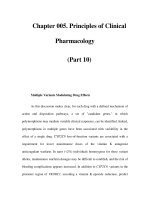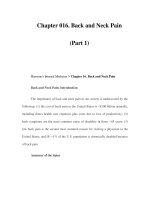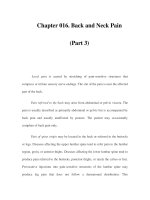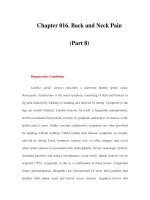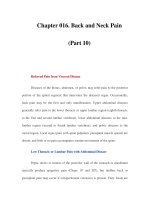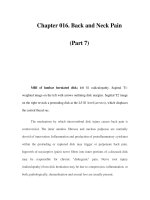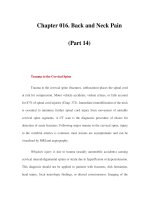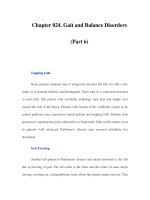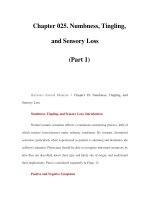Chapter 116. Immunization Principles and Vaccine Use (Part 10) ppsx
Bạn đang xem bản rút gọn của tài liệu. Xem và tải ngay bản đầy đủ của tài liệu tại đây (44.95 KB, 5 trang )
Chapter 116. Immunization Principles
and Vaccine Use
(Part 10)
An illuminating example is the case of Rotashield, a rhesus reassortant
rotavirus vaccine, which was introduced for routine use in the United States in the
late 1990s. Within 9 months of its introduction, cases of intussusception were
reported by the CDC to be temporally associated with the administration of the
initial vaccine dose. This report led first to the cessation of the vaccine's use and
subsequently to its withdrawal from the market and the discontinuation of its
production. The withdrawal of the vaccine in the United States made its use
impossible in developing countries, where the risk of any increase in
intussusception would have been dramatically outweighed by the benefit of
decreased rotavirus mortality rates. It is now apparent that the susceptibility to
intussception is age related, with virtually no events in children <90 days of age.
Almost a decade later, a new rotavirus vaccine has been licensed in the United
States and recommended for routine use beginning at ≤2 months of age. In the
interim, some 4–5 million infants have died of rotavirus diarrhea in the developing
world; most of these deaths could have been prevented by the original rhesus
rotavirus vaccine.
Vaccine components, including protective antigens, animal proteins
introduced during vaccine production, and antibiotics or other preservatives or
stabilizers, can certainly cause allergic reactions in some recipients. These
reactions may be local or systemic, including urticaria and serious anaphylaxis.
The most common extraneous allergen is egg protein derived from the growth of
measles, mumps, influenza, and yellow fever viruses in embryonated eggs.
Gelatin, used as a heat stabilizer, has been implicated in rare but severe allergic
reactions. Local or systemic reactions (probably due to antigen-antibody
complexes) can result from the too frequent administration of vaccines such as Td
or rabies vaccine. Because live-virus vaccines can interfere with tuberculin test
responses, necessary tuberculin testing should be done either on the day of
immunization or at least 6 weeks later.
Use of Vaccines in Special Circumstances
Breast Feeding
Neither killed nor live vaccines affect the safety of breast feeding for either
mother or infant. Breast-fed infants can be immunized on a normal schedule. Even
premature infants can be immunized at their appropriate chronologic age.
Seroconversion in response to hepatitis vaccine at birth may be impaired in some
premature infants with birth weights of <2000 g. By a chronologic age of 1 month,
however, premature infants—regardless of initial birth weight or gestational age—
are as likely to respond adequately to vaccines as older and larger infants.
Occupational Exposure
Immunization recommendations for most occupational groups remain to be
developed. Specific practices for the immunization of U.S. health care workers
against hepatitis B are mandated by the Occupational Safety and Health
Administration. Persons employed in caring for patients with chronic diseases can
transmit influenza and should be vaccinated annually, independent of age. Rubella
is transmitted to and from health care workers in medical facilities, particularly in
pediatric practice. Health care workers who might transmit rubella to pregnant
patients should be documented to be immune to rubella; susceptible individuals
should be promptly immunized. Persons providing health care are also at greater
risk from measles and varicella than the general public, and those who are likely to
come into contact with measles- and varicella-infected patients should be
documented to be immune or be immunized.
HIV Infection and Other Medical Conditions
Limited studies in HIV-infected individuals have found no increase in the
risk of adverse events from the use of live or inactivated vaccines. It is not
surprising that immune responses may not be as vigorous in immunocompromised
individuals as in those with a normal immune system; therefore, persons known to
be infected with HIV should be immunized with recommended vaccines in the
same manner as individuals with a normal immune system and as early in the
course of their disease as possible, before immune function becomes significantly
impaired. If MMR immunization is indicated, HIV-infected patients may receive
the standard attenuated vaccine; if polio vaccination is required, these patients and
their household contacts should receive inactivated polio vaccine.
Albeit prudent, it is not necessary to test for HIV before making decisions
about the immunization of asymptomatic individuals from known HIV risk
groups. Live attenuated vaccines are contraindicated in other
immunocompromised patients, including those with congenital immunodeficiency
syndromes, those who have undergone splenectomy, and those who are receiving
immunosuppressive therapy. Passive immunization with immunoglobulin
preparations or antitoxins can be considered in individual cases, either as
postexposure prophylaxis or as part of the treatment of established infection.
Travel
(See also Chap. 117) The International Sanitary Regulations allow
countries to impose requirements for yellow fever and killed cholera vaccines as a
condition for admission, even though the latter vaccine is not an effective public
health tool. Travelers should know whether these vaccines are required for entry
into the countries on their itinerary to avoid being turned back or immunized on
the spot, with the inherent danger of unsafe injections in poor developing
countries. Infants, children, and adults should have all routine immunizations
updated before traveling, especially to developing countries, with particular
attention to polio, measles, and DTaP or Tdap, depending on age. Immunity to
hepatitis A and hepatitis B is advisable for travelers. Special-use vaccines (Table
116-2), including rabies, typhoid, Japanese B encephalitis, and plague vaccines,
should be considered for those individuals who expect to go beyond the usual
tourist routes or to spend extended periods in rural areas in disease-endemic
regions. Most U.S. cities have travel clinics that maintain up-to-date
epidemiologic information and can provide the appropriate vaccines. The CDC
maintains a useful website for travelers (

